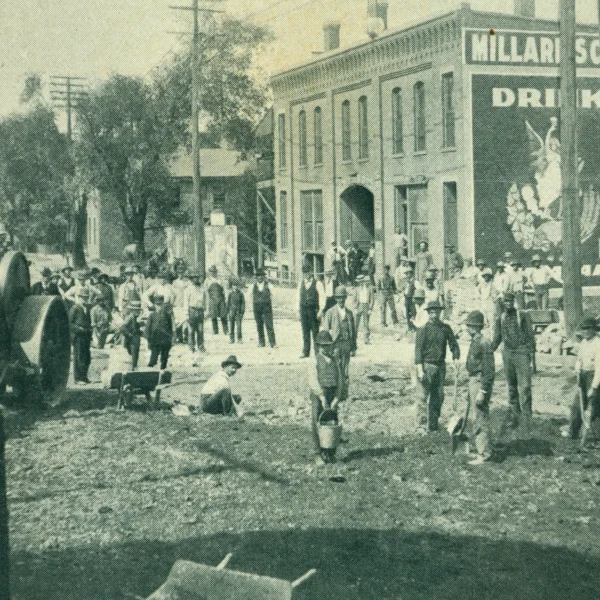At the southwest corner of the Courthouse Square, near the intersection of Center and Washington streets, stands a historic marker of brick topped by a bronze plaque. “Center Street site,” it reads. “First brick pavement in the United States / Innovation to Modern Highways / Installed 1877.”
Mighty impressive. Unfortunately, the claim of “first” is simply not true.
This well-worn myth has been around for nearly a century, if not longer, though as oftentimes is the case with local legends and lore, there is some truth to the story. The plaque correctly states that Napoleon B. Heafer “installed” a stretch of brick pavement in 1877, and it’s mostly correct in that this represented an “innovation to modern highways” (though “streets” would be a more appropriate word choice than “highways.”)
In fact, by 1900, the “Bloomington System” of street paving was well-known to city officials and engineers across much of the Midwest. Descriptions of the local method appeared in technical manuals and in the general interest magazine Century. Delegations also visited Bloomington to check out its state-of-the-art pavement.
Although Heafer cannot claim the first brick street, he certainly was an early pioneer in the movement.
For the record, the first U.S. patent for brick paving dates to 1868, and the nation’s first full block of brick paving in 1873, with Charleston, WV, claiming the honors.
It’s difficult for one to exaggerate the transformative nature of brick pavement. Objects left on the streets, even dead animals, would be trampled further into the mud and muck. In the 1850s, one observer identified various items driven into the mud, including a broken lamppost, large barrel, granite blocks, stone jug, window frame and pieces of pig iron.
“A continent of mud fathomless and shoreless, they are the terror of strangers and the disgust of her citizens,” was how one visitor to Bloomington described its streets in 1859. “Her streets,” this visitor added of Bloomington, “instead of being an honor and an ornament, are her greatest discredit.
With no ready access to building stone, local officials had to look elsewhere. Bloomington’s first paved (albeit non-brick) street was a stretch of East Grove, where layers of crushed rock were laid down in order to facilitate the traffic between downtown and the Illinois Central Railroad depot (located roughly where Beer Nuts stands today.) Gravel was spread on other main thoroughfares and side streets, though heavy rains and traffic quickly created monster potholes known as “duck ponds.” City officials also paved a handful of streets with creosote-soaked wood block, surviving patches of which might still be seen in the drives of a few Grove Street residences.
Two years later, 1875, Bloomington brick maker Napoleon Heafer (his middle initial “B” stood for Bonaparte, naturally) received permission from city officials to install a test patch of brick pavement measuring some 120 square feet at the corner of Center and Washington streets. Heafer’s system featured a four-inch layer of coal cinders topped in sand, followed by a layer of common building bricks laid flat, more sand atop that, and then a second layer of bricks, this time set on edge. The test patch was put down in the spring, and that fall the surface bricks were removed and inspected for wear and tear.
Although the experiment proved a success (much to the surprise of skeptics) it took another two years for Heafer and his business partner John McGregor to convince the city council to pave the entire one-block stretch of North Center Street running along the west side of the Courthouse Square. This too proved a success, for the street was not repaved until 1892.
Once brick paving took off, city officials divided up contracts among three local brick makers, who in turn charged identical price. The quality of Bloomington brick suffered from softness and high porosity, a consequence of low (relatively speaking) kiln temperatures and impurities of the local clay supply. These softer bricks were ill-suited to the punishing grind of 19th century traffic, such as heavy wagon wheels made of iron and steel.
In 1896, John Cherry of Jacksonville became the first outsider to receive a pavement contract from the city (see accompanying image.) He also used out-of-town brick, and soon enough Bloomington manufacturers found they could not compete with machine-made, ground shale brick baked at high industrial temperatures. “The American shale paver was surely one of the most indestructible objects created in the 19th century; many equal the hardness of high-grade steel and will scratch quartz,” noted William D. Walters, Jr., an emeritus professor in historical geography from Illinois State University who has studied this topic at length.
Heafer’s operation and those of his competitors are long gone, but their clay pits survive as the collection of small lakes scattered at the south end of Bloomington.
By 1926, Bloomington had more than 46 miles of brick streets, about 7 of asphalt and 6 of concrete. Brick remained the dominant surface into the late 1930s. Over the next several decades, though, many of the city’s brick streets were buried under one or more layers of concrete or asphalt. In 2017, the city approved a master plan to protect its remaining 3.5 miles of brick streets.
Another factual error on the Center Street plaque is the claim that the plaque itself is “set in original paving brick.” The bricks are actually shale pavers produced many years after the 1877 experiment!
A decade or so ago, vandals chipped away at the mortar and removed several bricks, believing perhaps they were now in possession of a valuable piece of U.S. history. One would like to think the local history gods got a good laugh this sad case of petty thievery.

